5 to 10 January, 2014 - Vigan, Pagudpud, Mt Pinatubo - (Philippines)
It was time to lose some altitude. After all, we didn't come to The Philippines to be cold. The most obvious route, on a map, was not the easiest, with very few transport connections and options. But soon enough, we were delighted to be in the warmer climes of the coast.
Our first stops, though, were not to be beaches. World Heritage Spanish Colonial architecture was our focus for a couple of days, and Vigan was a great place to have our anniversary. We upped the accommodation a bit, and spent two nights in a former mansion, full of delightful antiques. It had that touch of class that we are becoming familiar with, now that we are "business class worthy" travellers!
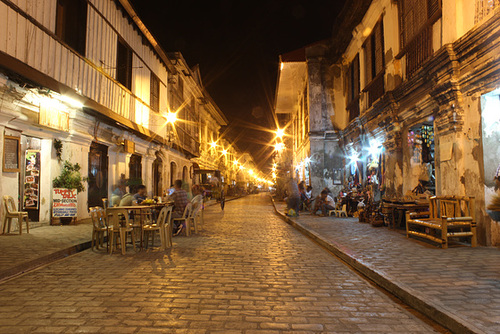
Spanish Colonial Architecture
The Spanish centre of Vigan, The Philippines. It was spared in WWII just minutes before being flattened by American bombers. The architecture is actually a mix of Spanish and Chinese influences.
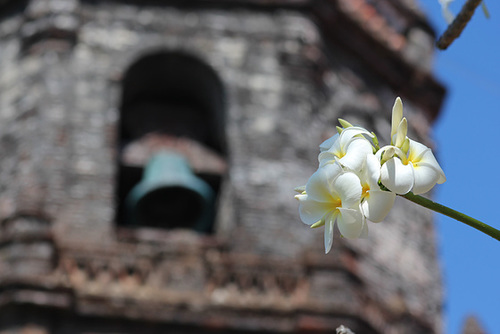
Frangipani and Bell
At Santa Maria.
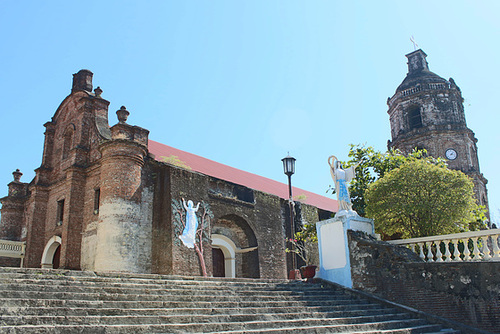
Santa Maria
Church of Santa Maria, near Vigan. Huge, and solid.

Happy Anniversary
Celebrating 24 wonderful years together. Vigan.
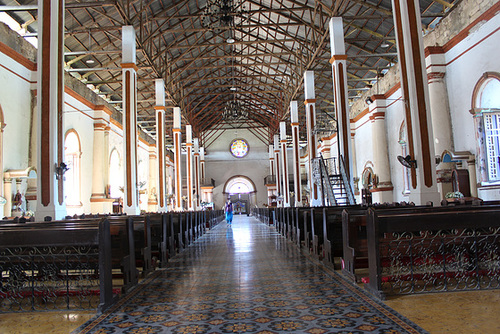
Spacious Interior
The incredibly light and airy interior of the church of Paoay.
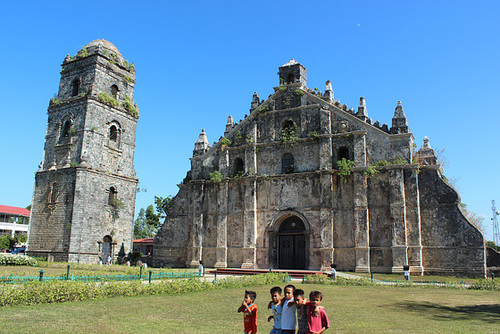
Paoay Church
We saw this style referred to as "Earthquake Baroque". Made primarily from coral rocks, the walls are incredibly thick and have huge fortress like reinforcements. While very Spanish, it still displays many other influences. Hints of Indonesian and Chinese can be discerned.
A bit further north, and we reached our first beach stop.
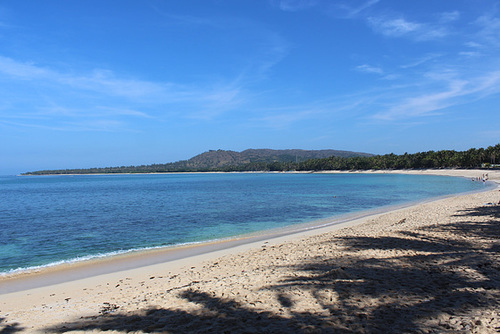
Saud Beach, Pagudpud
An idyllic stretch of sand in the north Luzon, Phillipines.
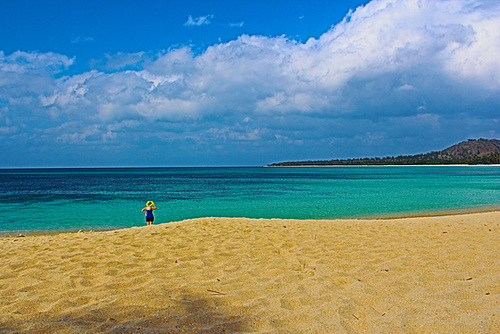
Art Effect
A nice "art effect" added. Saud Beach, Pagudpud.
After some confusing phone calls, and a bit of weighing up of options, we hopped on what was supposed to be an "overnight" bus south. Have you ever noticed, that when you want a bus trip to take a bit longer, it is usually a bit shorter? Subsequently, we were deposited by the side of the highway at 2:30 in the morning. A couple of motor tricycle rides later, and we were near the foot of Mt Pinatubo.
The driver implied that the building was accommodation of some sort, and proceeded to wake the inhabitants up. Dogs barked wildly. Chickens started flapping through the yard. And after a few minutes, lights appeared from within the building. It was nearly 4 a.m. We asked about the possibility of a room, and were dutifully informed that perhaps we should forego sleep. After all, we could commence ascending the mountain at 5:30. Jo managed to convey our level of tiredness, having been deprived of rest for much of the bus trip, and what sleep we got being very light and intermittent.
By now, most of the family seemed to have been awakened by our arrival, and they began busying themselves with various jobs, one of which was preparing a room for us to sleep in. As we went to the room we passed a figure, covered head to toe, trying to sleep on a couch. Perhaps the only person in the place still doing so. Nearly two hours later, when we got up and had breakfast, we worked out that the person on the couch was the teenage daughter. She had been evicted from her room so that we had somewhere to sleep!
6:30, or maybe approaching 7:00, and we were in a jeep taking us up to where the walking was to commence. Less than 3 hours later, we stood on the rim of Mt Pinatubo, admiring the incredibly beautiful crater lake within. The sulphurous smells, the discoloured rocks and water, these reminded us it was active. And the local guide we chatted to, his story of lost loved ones in the 1991 erruption, that reminded us that looks can be deceiving.
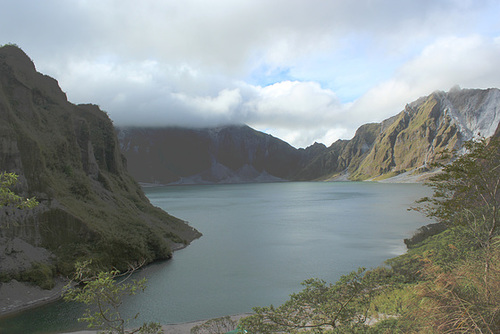
Looking Down Into Mt Pinatubo Crater Lake
After an overnight bus, and feeling very sleep deprived, we climbed Mt Pinatubo. Admittedly, we got driven a fair way up, but the last couple of hours to the rim were on foot. And looking down in to a superbly beautiful lake with some stunning scenery made it all worthwhile.
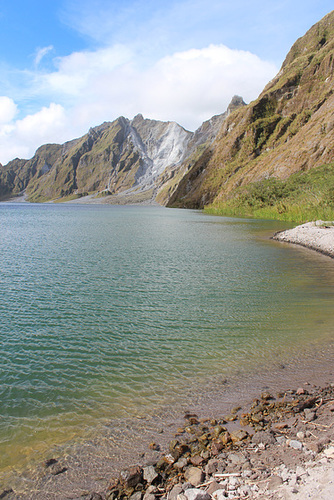
Lakeside, Mt Pinatubo
Photo from the shore of the crater lake inside Mt Pinatubo. There is little evidence of the fact that the volcano is still very active, having significant erruptions in the last few decades.
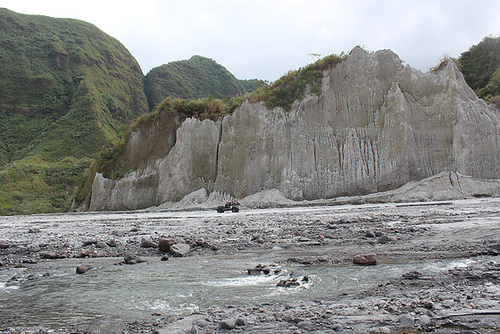
Driving Down, Mt Pinatubo
The river down from Mt Pinatubo is largely just loose ash from recent erruptions. It is a significant hazard, as any decent amount of rain, particularly a typhoon, does not get absorbed, but turns the river very quickly in to mud and ash flows, with dangerous land slides possible at any time.
It was time to lose some altitude. After all, we didn't come to The Philippines to be cold. The most obvious route, on a map, was not the easiest, with very few transport connections and options. But soon enough, we were delighted to be in the warmer climes of the coast.
Our first stops, though, were not to be beaches. World Heritage Spanish Colonial architecture was our focus for a couple of days, and Vigan was a great place to have our anniversary. We upped the accommodation a bit, and spent two nights in a former mansion, full of delightful antiques. It had that touch of class that we are becoming familiar with, now that we are "business class worthy" travellers!

Spanish Colonial Architecture
The Spanish centre of Vigan, The Philippines. It was spared in WWII just minutes before being flattened by American bombers. The architecture is actually a mix of Spanish and Chinese influences.

Frangipani and Bell
At Santa Maria.

Santa Maria
Church of Santa Maria, near Vigan. Huge, and solid.

Happy Anniversary
Celebrating 24 wonderful years together. Vigan.

Spacious Interior
The incredibly light and airy interior of the church of Paoay.

Paoay Church
We saw this style referred to as "Earthquake Baroque". Made primarily from coral rocks, the walls are incredibly thick and have huge fortress like reinforcements. While very Spanish, it still displays many other influences. Hints of Indonesian and Chinese can be discerned.
A bit further north, and we reached our first beach stop.

Saud Beach, Pagudpud
An idyllic stretch of sand in the north Luzon, Phillipines.

Art Effect
A nice "art effect" added. Saud Beach, Pagudpud.
After some confusing phone calls, and a bit of weighing up of options, we hopped on what was supposed to be an "overnight" bus south. Have you ever noticed, that when you want a bus trip to take a bit longer, it is usually a bit shorter? Subsequently, we were deposited by the side of the highway at 2:30 in the morning. A couple of motor tricycle rides later, and we were near the foot of Mt Pinatubo.
The driver implied that the building was accommodation of some sort, and proceeded to wake the inhabitants up. Dogs barked wildly. Chickens started flapping through the yard. And after a few minutes, lights appeared from within the building. It was nearly 4 a.m. We asked about the possibility of a room, and were dutifully informed that perhaps we should forego sleep. After all, we could commence ascending the mountain at 5:30. Jo managed to convey our level of tiredness, having been deprived of rest for much of the bus trip, and what sleep we got being very light and intermittent.
By now, most of the family seemed to have been awakened by our arrival, and they began busying themselves with various jobs, one of which was preparing a room for us to sleep in. As we went to the room we passed a figure, covered head to toe, trying to sleep on a couch. Perhaps the only person in the place still doing so. Nearly two hours later, when we got up and had breakfast, we worked out that the person on the couch was the teenage daughter. She had been evicted from her room so that we had somewhere to sleep!
6:30, or maybe approaching 7:00, and we were in a jeep taking us up to where the walking was to commence. Less than 3 hours later, we stood on the rim of Mt Pinatubo, admiring the incredibly beautiful crater lake within. The sulphurous smells, the discoloured rocks and water, these reminded us it was active. And the local guide we chatted to, his story of lost loved ones in the 1991 erruption, that reminded us that looks can be deceiving.

Looking Down Into Mt Pinatubo Crater Lake
After an overnight bus, and feeling very sleep deprived, we climbed Mt Pinatubo. Admittedly, we got driven a fair way up, but the last couple of hours to the rim were on foot. And looking down in to a superbly beautiful lake with some stunning scenery made it all worthwhile.

Lakeside, Mt Pinatubo
Photo from the shore of the crater lake inside Mt Pinatubo. There is little evidence of the fact that the volcano is still very active, having significant erruptions in the last few decades.

Driving Down, Mt Pinatubo
The river down from Mt Pinatubo is largely just loose ash from recent erruptions. It is a significant hazard, as any decent amount of rain, particularly a typhoon, does not get absorbed, but turns the river very quickly in to mud and ash flows, with dangerous land slides possible at any time.
No comments:
Post a Comment